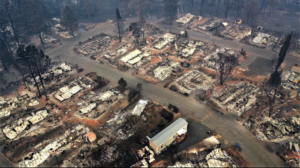This guest blog was written by Thomas Tenorio, CEO of the Community Action Agency of Butte County, in partnership with the California Department of Community Services and Development (CSD). CSD is the CSBG Grantee for the State of California.
The CSBG Network covers 99% of the counties across the entire country and is made up of over 1,000 Community Action Agencies. These CAAs represent a practical delivery system for much needed antipoverty services to low-income individuals, families, and communities. CAAs are also a trusted local presence when conditions are at their worst – in the wake of disasters.
Whether natural or man-made, disasters put an incredible demand on human services organizations – to plan better on the front end, to mitigate the impact in the aftermath, and to assist with the recovery in the months to follow. But in the CSBG network, there is a dimension of organizational culture that is manifested during these worst of times. It is the human face of our mission in the wake of tragedy. This occurs at different levels: from our local community, to the State CSBG office in Sacramento. The spirit of Community Action can be that needed inspiration when tragedy strikes and when it seems that no end is in sight.
On November 8, 2018 the Camp Fire became the deadliest and most destructive wildfire in California state history. It also was the deadliest disaster in the entire country in the last 100 years. The fire burned for 17 days and spread so quickly that, at one point, it burned the length of one football field per second. In total the fire burned an area over 153,000 acres, destroyed approximately 14,000 homes, 5,000 commercial structures, and created the largest environmental disaster in California state history, with estimated damages close to $16 billion. Approximately 93% of the town of Paradise and much of the surrounding community was destroyed. Worst of all, 85 residents tragically lost their lives to the fire.
Within hours of the fire that started early on a Thursday, the CAA’s North State Food Bank (NSFB) began providing food and supplies to evacuation centers and the many impromptu shelters that popped up because of the sheer magnitude of the people fleeing the fire. Within the first several months after the disaster, over 700,000 pounds of food were delivered.
It was during the initial hours and days of the fire that the staff of the Community Action Agency of Butte County, Inc. (CAA) and the State CSBG Agency, the California Department of Community Services and Development (CSD) jumped into action. CAA of Butte County consulted with State CSD who offered its assistance and support within hours of the fire’s start. As a result, the State approved critical flexibility in the use of Energy Program and Community Services Block Grant (CSBG) funding that allowed the CAA to serve survivors of the fire with shelter, gift cards to pay for critical expenses, and direct payments to lodging vendors.
Fairgrounds facilities, churches, community organizations, and schools were all opened to accommodate the mass influx of people. All hotel rooms in a 75-mile radius were occupied. Many remain occupied today, six months later. These supports complemented the continued delivery of food that came from the CAA’s engaged food bank network.

These immediate responses enabled survivors, including some of our own staff who were directly impacted by the fire, to retain a measure of hope. This hope was necessary with so many uncertainties facing local residents. It is only now that the magnitude of the impact is becoming clear. The fire created hazardous materials that hamper the recovery effort. The water systems have been deemed so contaminated that the water cannot be used even after boiling. Federal and State emergency service officials have repeatedly stated that there is no “playbook” to use in guiding next steps in efforts to recover.
With the State’s assistance, CAA of Butte County is embarking on its next phase of support to disaster survivors. California faces an affordable housing shortage, and after the fire it has become nearly impossible for survivors to locate housing in the area. Many are stuck in hotel or motel rooms, spare bedrooms, trailers, or are couch surfing. The Paradise Ridge has historically been home to many low-income residents and seniors. The area was known for its older, more affordable housing stock and unique options with many shared housing arrangements. Many residents were uninsured or under-insured, thus leaving them particularly vulnerable to economic impacts of a disaster and with very few options for recovery.
The CAA of Butte County will now focus on support and assistance through comprehensive case management to help people to develop and execute a plan for the road ahead. With resources made available from nationwide responses to our call for donations, we are continuing to help people meet immediate needs. We are also assisting individuals and families in the relocation process if this turns out to be their best option. Because of our role as hubs for various federal, state, and local programs, CAA’s are uniquely equipped to provide services tailored to the needs of our communities.
Preparing for disaster is prudent, responsible, and yet, an area that we can all improve in personally and professionally. Community Action is not only working to support our community’s recovery, but also to increase our community’s disaster preparedness and resiliency going forward. The responses of CAA and State Agency staff were nothing short of inspiring. Many CAA staff lost their own homes in the fire and continue to be impacted by the affordable housing shortage – they still report to work every day seeking to help lift up the entire community. From our local team, to the supportive staff at the State CSBG office, we have witnessed the true commitment of people living the Promise of Community Action.





